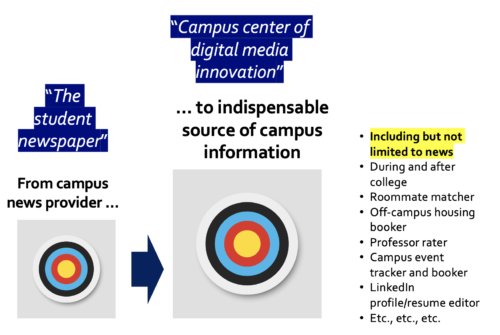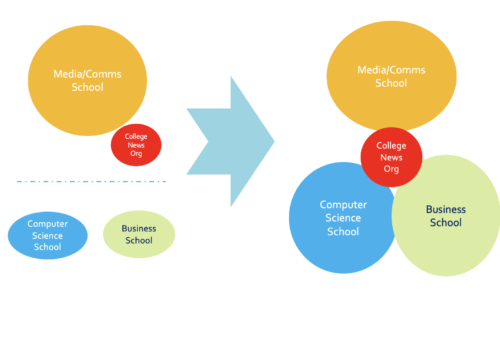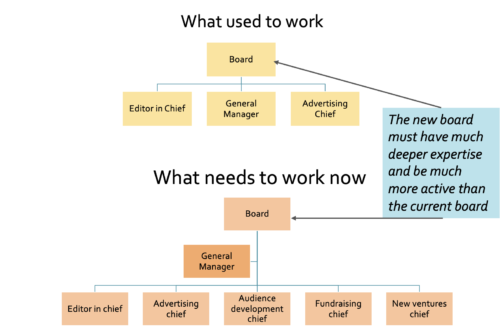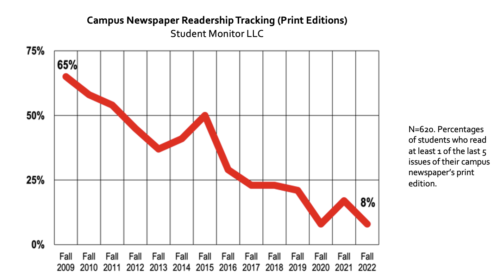During Penn State’s “We Are Weekend,” the two principals who led nine months of research into best practices to revitalize The Daily Collegian presented their recommendations to an audience of 30 that included Collegian students and alumni and university officials.
Bob Buday, one of the two principals who led the research team of nine Collegian alumni and one former editor in chief of The Daily Emerald, said near the end of the nearly three-hour presentation, “Great opportunities are out there, but college news organizations (CNOs) can’t take advantage of them if they continue to do the same things they have done for the past 50 years.”

The Collegian needs to be an indispensable source of campus information
Buday, author and CEO of Buday Thought Leadership Partners, and the other principal researcher, Bill Guthlein, a business planning, financial and data analysis consultant and principal at WJG Associates, warned that cannot rely on revenue from advertising.
They said innovation and cross-media collaboration are essential for The Collegian to survive. They offered examples of innovations that have generated significant revenue for other CNOs. One provides a professor rating service (Columbia Spectator), another matches students to apartments (Duke Chronicle) and a third licenses its web content management system to other CNOs (Michigan State University’s State News).
While not traditional news, these services provide indispensable information to students and other value, Bob and Bill noted. To thrive, The Collegian must become an indispensable source of both useful and crucial information to PSU students, professors, staff and administrators, they said. To help with innovation, Bob and Bill said, The Collegian should work with experts in Penn State’s Smeal College of Business and the College of Information Sciences and Technology.

Collaborating with students from the business and information technology schools is crucial for innovation
Bob and Bill also urged The Collegian to closely collaborate and cooperate with the other Donald P. Bellisario College of Communications student media, including its TV and radio stations. Highly successful news sites such as The New York Times today regularly tell the news through video, audio, podcast interviews, and interactive charts and other graphics – not just through traditional text and photographs. Penn State’s TV and radio stations have long developed deep skills in video and audio production. In a world in which stories increasingly need to be told through multiple digital media to provide a superior viewer experience, Bob and Bill said it makes no sense anymore for newspaper, TV and radio journalists to work independently and resist collaboration.
Bellisario College Dean Marie Hardin, who attended the session along with Michael Poorman, the college’s director of alumni relations, described the consortium of Penn State student media she created that enabled The Collegian to get $200,000 from the Student Fee Board this year. She intervened after the university ended all subsidies for The Collegian, which, two years ago, were as high as $450,000 a year.
In addition to The Collegian, the five-member consortium includes the Bellisario-affiliated CommRadio, Centre County Report, PSN-TV and WKPS Radio (The Lion 90.7).
Bob and Bill said they fully support Dean Hardin’s contention that the five should work together, exploiting the strengths and skills of each, to jointly produce indispensable information in a variety of ways, from podcasts to broadcasts to web stories with interactive photos and charts. Such multimedia offerings, Bob said, are far more powerful than just a printed news story or a TV- or radio-only report.
What’s more, to attract many more viewers, all Penn State news media must heavily promote their stories on social media. In addition, they should work together to create a great smartphone app – a “killer app” that would be the PSU version of NYTimes.com or ESPN.com – that students rely on wherever they are, on and off campus.
Bob and Bill are working with Dean Hardin to present the research findings to all members of the consortium.
The research team studied 23 years’ worth of 990 income tax forms from 33 nonprofit CNOs (including The Collegian) that are independent from their universities (from FY2000-01 to FY2022-23). They interviewed leaders at 21 CNOs, which often included the general manager, board chair, student editor in chief and student advertising manager. No one else they could find has gathered this data. That enabled the team to pinpoint real, and often disturbing, trends, including a decline of 51 percent in CNO annual revenue from 2006-07 to 2022-23.

The board of directors of a college news organization must contain members with expertise in areas crucial to media success
The team, including Bob and Bill who left journalism for careers in business, has devoted hundreds of hours of research to the project because the members believe their experience on The Collegian (and for one member, The Daily Emerald) was life-changing, and they wanted to preserve that for future generations. As one of their slides put it, “CNOs are failing at a key mission, and rapidly. We’re talking about readership.”
They enlisted the assistance of Dean Hardin, business experts and Student Monitor LLC, the nation’s top college market research company. Student Monitor provided shocking information about readership. In 2009, 65 percent of college students The Monitor surveyed on 100 U.S. campuses read their campus paper. By 2022, only 8 percent did, and only 18 precent read the digital edition.

To regain audience, college news organizations must find out what students want from them
Bob said during their presentation, “The Collegian and the larger Student News Consortium can play a key role in the digital renaissance of news media. We hope they seize the opportunity.” The rebirth of what is currently disappearing local media should begin with college media, which has more room to innovate and more academic expertise on campus to tap, Bob said.
During the question-and-answer session that followed the presentation, the two students from The Collegian who attended, Sam Woloson, managing editor, and Joe Tuman, social media editor and sports reporters, talked about Collegian students working with the other Student Media Consortium members.
Joe, who also works for CommRadio, said he felt all of the outlets should collaborate, but he foresaw some problems.
Sam said he foresaw difficulty in trying to get the organizations to work together because they see each other as competitors.
Collegian alumnus Tim Panaccio, an award-winning journalist for the Philadelphia Inquirer and Comcast Sports, pointed out that if the students who work for the various consortium members cooperate, then all of them will learn and hone skills that will make them much more valuable and employable when they graduate.
Bob agreed, noting that local newspapers are dying. “The single-skill journalist is not an attractive candidate,” he said.
Joe said the consortium members, who are now completely separate, should get together and brainstorm how they can work together. Sam agreed and said students need to know that if they don’t cooperate, the Collegian may cease to exist and that cooperation means learning great skills.
Click here to view a recording of the presentation. Because of various technical problems, the presentation does not begin until 23.50 minutes into the recording. Just fast forward to there, where you will hear Dean Hardin talking about the Student Media Consortium.


